#laravel 5 tutorial
Explore tagged Tumblr posts
Text
Top 10 Laravel Development Companies in the USA in 2024
Laravel is a widely-used open-source PHP web framework designed for creating web applications using the model-view-controller (MVC) architectural pattern. It offers developers a structured and expressive syntax, as well as a variety of built-in features and tools to enhance the efficiency and enjoyment of the development process.

Key components of Laravel include:
1. Eloquent ORM (Object-Relational Mapping): Laravel simplifies database interactions by enabling developers to work with database records as objects through a powerful ORM.
2. Routing: Laravel provides a straightforward and expressive method for defining application routes, simplifying the handling of incoming HTTP requests.
3. Middleware: This feature allows for the filtering of HTTP requests entering the application, making it useful for tasks like authentication, logging, and CSRF protection.
4. Artisan CLI (Command Line Interface): Laravel comes with Artisan, a robust command-line tool that offers commands for tasks such as database migrations, seeding, and generating boilerplate code.
5. Database Migrations and Seeding: Laravel's migration system enables version control of the database schema and easy sharing of changes across the team. Seeding allows for populating the database with test data.
6. Queue Management: Laravel's queue system permits deferred or background processing of tasks, which can enhance application performance and responsiveness.
7. Task Scheduling: Laravel provides a convenient way to define scheduled tasks within the application.
What are the reasons to opt for Laravel Web Development?
Laravel makes web development easier, developers more productive, and web applications more secure and scalable, making it one of the most important frameworks in web development.
There are multiple compelling reasons to choose Laravel for web development:
1. Clean and Organized Code: Laravel provides a sleek and expressive syntax, making writing and maintaining code simple. Its well-structured architecture follows the MVC pattern, enhancing code readability and maintainability.
2. Extensive Feature Set: Laravel comes with a wide range of built-in features and tools, including authentication, routing, caching, and session management.
3. Rapid Development: With built-in templates, ORM (Object-Relational Mapping), and powerful CLI (Command Line Interface) tools, Laravel empowers developers to build web applications quickly and efficiently.
4. Robust Security Measures: Laravel incorporates various security features such as encryption, CSRF (Cross-Site Request Forgery) protection, authentication, and authorization mechanisms.
5. Thriving Community and Ecosystem: Laravel boasts a large and active community of developers who provide extensive documentation, tutorials, and forums for support.
6. Database Management: Laravel's migration system allows developers to manage database schemas effortlessly, enabling version control and easy sharing of database changes across teams. Seeders facilitate the seeding of databases with test data, streamlining the testing and development process.
7. Comprehensive Testing Support: Laravel offers robust testing support, including integration with PHPUnit for writing unit and feature tests. It ensures that applications are thoroughly tested and reliable, reducing the risk of bugs and issues in production.
8. Scalability and Performance: Laravel provides scalability options such as database sharding, queue management, and caching mechanisms. These features enable applications to handle increased traffic and scale effectively.
Top 10 Laravel Development Companies in the USA in 2024
The Laravel framework is widely utilised by top Laravel development companies. It stands out among other web application development frameworks due to its advanced features and development tools that expedite web development. Therefore, this article aims to provide a list of the top 10 Laravel Development Companies in 2024, assisting you in selecting a suitable Laravel development company in the USA for your project.
IBR Infotech

IBR Infotech excels in providing high-quality Laravel web development services through its team of skilled Laravel developers. Enhance your online visibility with their committed Laravel development team, which is prepared to turn your ideas into reality accurately and effectively. Count on their top-notch services to receive the best as they customise solutions to your business requirements. Being a well-known Laravel Web Development Company IBR infotech is offering the We provide bespoke Laravel solutions to our worldwide customer base in the United States, United Kingdom, Europe, and Australia, ensuring prompt delivery and competitive pricing.
Additional Information-
GoodFirms : 5.0
Avg. hourly rate: $25 — $49 / hr
No. Employee: 10–49
Founded Year : 2014
Verve Systems
Elevate your enterprise with Verve Systems' Laravel development expertise. They craft scalable, user-centric web applications using the powerful Laravel framework. Their solutions enhance consumer experience through intuitive interfaces and ensure security and performance for your business.
Additional Information-
GoodFirms : 5.0
Avg. hourly rate: $25
No. Employee: 50–249
Founded Year : 2009
KrishaWeb

KrishaWeb is a world-class Laravel Development company that offers tailor-made web solutions to our clients. Whether you are stuck up with a website concept or want an AI-integrated application or a fully-fledged enterprise Laravel application, they can help you.
Additional Information-
GoodFirms : 5.0
Avg. hourly rate: $50 - $99/hr
No. Employee: 50 - 249
Founded Year : 2008
Bacancy
Bacancy is a top-rated Laravel Development Company in India, USA, Canada, and Australia. They follow Agile SDLC methodology to build enterprise-grade solutions using the Laravel framework. They use Ajax-enabled widgets, model view controller patterns, and built-in tools to create robust, reliable, and scalable web solutions
Additional Information-
GoodFirms : 4.8
Avg. hourly rate: $25 - $49/hr
No. Employee: 250 - 999
Founded Year : 2011
Elsner
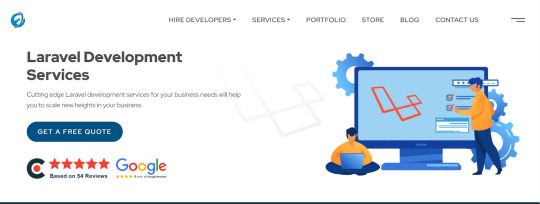
Elsner Technologies is a Laravel development company that has gained a high level of expertise in Laravel, one of the most popular PHP-based frameworks available in the market today. With the help of their Laravel Web Development services, you can expect both professional and highly imaginative web and mobile applications.
Additional Information-
GoodFirms : 5
Avg. hourly rate: < $25/hr
No. Employee: 250 - 999
Founded Year : 2006
Logicspice

Logicspice stands as an expert and professional Laravel web development service provider, catering to enterprises of diverse scales and industries. Leveraging the prowess of Laravel, an open-source PHP framework renowned for its ability to expedite the creation of secure, scalable, and feature-rich web applications.
Additional Information-
GoodFirms : 5
Avg. hourly rate: < $25/hr
No. Employee: 50 - 249
Founded Year : 2006
Sapphire Software Solutions
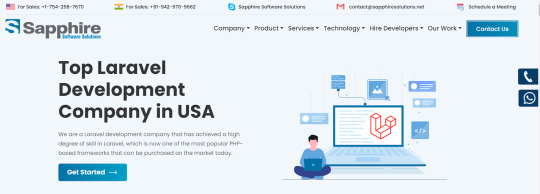
Sapphire Software Solutions, a leading Laravel development company in the USA, specialises in customised Laravel development, enterprise solutions,.With a reputation for excellence, they deliver top-notch services tailored to meet your unique business needs.
Additional Information-
GoodFirms : 5
Avg. hourly rate: NA
No. Employee: 50 - 249
Founded Year : 2002
iGex Solutions
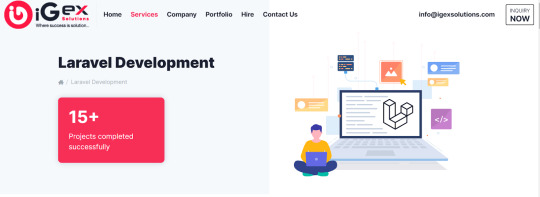
iGex Solutions offers the World’s Best Laravel Development Services with 14+ years of Industry Experience. They have 10+ Laravel Developer Experts. 100+ Elite Happy Clients from there Services. 100% Client Satisfaction Services with Affordable Laravel Development Cost.
Additional Information-
GoodFirms : 4.7
Avg. hourly rate: < $25/hr
No. Employee: 10 - 49
Founded Year : 2009
Hidden Brains
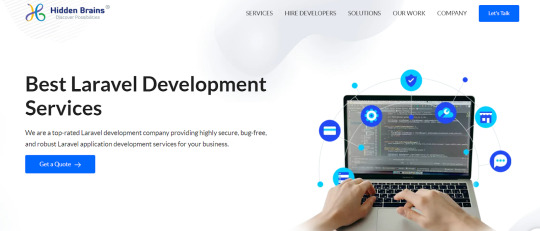
Hidden Brains is a leading Laravel web development company, building high-performance Laravel applications using the advantage of Laravel's framework features. As a reputed Laravel application development company, they believe your web application should accomplish the goals and can stay ahead of the rest.
Additional Information-
GoodFirms : 4.9
Avg. hourly rate: < $25/hr
No. Employee: 250 - 999
Founded Year : 2003
Matellio
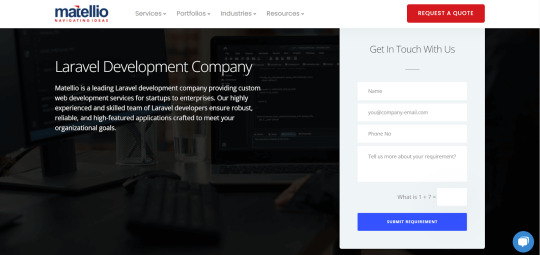
At Matellio, They offer a wide range of custom Laravel web development services to meet the unique needs of their global clientele. There expert Laravel developers have extensive experience creating robust, reliable, and feature-rich applications
Additional Information-
GoodFirms : 4.8
Avg. hourly rate: $50 - $99/hr
No. Employee: 50 - 249
Founded Year : 2014
What advantages does Laravel offer for your web application development?
Laravel, a popular PHP framework, offers several advantages for web application development:
Elegant Syntax
Modular Packaging
MVC Architecture Support
Database Migration System
Blade Templating Engine
Authentication and Authorization
Artisan Console
Testing Support
Community and Documentation
Conclusion:
I hope you found the information provided in the article to be enlightening and that it offered valuable insights into the top Laravel development companies.
These reputable Laravel development companies have a proven track record of creating customised solutions for various sectors, meeting client requirements with precision.
Over time, these highlighted Laravel developers for hire have completed numerous projects with success and are well-equipped to help advance your business.
Before finalising your choice of a Laravel web development partner, it is essential to request a detailed cost estimate and carefully examine their portfolio of past work.
#Laravel Development Companies#Laravel Development Companies in USA#Laravel Development Company#Laravel Web Development Companies#Laravel Web Development Services
2 notes
·
View notes
Text
Complete PHP Tutorial: Learn PHP from Scratch in 7 Days
Are you looking to learn backend web development and build dynamic websites with real functionality? You’re in the right place. Welcome to the Complete PHP Tutorial: Learn PHP from Scratch in 7 Days — a practical, beginner-friendly guide designed to help you master the fundamentals of PHP in just one week.
PHP, or Hypertext Preprocessor, is one of the most widely used server-side scripting languages on the web. It powers everything from small blogs to large-scale websites like Facebook and WordPress. Learning PHP opens up the door to back-end development, content management systems, and full-stack programming. Whether you're a complete beginner or have some experience with HTML/CSS, this tutorial is structured to help you learn PHP step by step with real-world examples.
Why Learn PHP?
Before diving into the tutorial, let’s understand why PHP is still relevant and worth learning in 2025:
Beginner-friendly: Easy syntax and wide support.
Open-source: Free to use with strong community support.
Cross-platform: Runs on Windows, macOS, Linux, and integrates with most servers.
Database integration: Works seamlessly with MySQL and other databases.
In-demand: Still heavily used in CMS platforms like WordPress, Joomla, and Drupal.
If you want to build contact forms, login systems, e-commerce platforms, or data-driven applications, PHP is a great place to start.
Day-by-Day Breakdown: Learn PHP from Scratch in 7 Days
Day 1: Introduction to PHP & Setup
Start by setting up your environment:
Install XAMPP or MAMP to create a local server.
Create your first .php file.
Learn how to embed PHP inside HTML.
Example:
<?php echo "Hello, PHP!"; ?>
What you’ll learn:
How PHP works on the server
Running PHP in your browser
Basic syntax and echo statement
Day 2: Variables, Data Types & Constants
Dive into PHP variables and data types:
$name = "John"; $age = 25; $is_student = true;
Key concepts:
Variable declaration and naming
Data types: String, Integer, Float, Boolean, Array
Constants and predefined variables ($_SERVER, $_GET, $_POST)
Day 3: Operators, Conditions & Control Flow
Learn how to make decisions in PHP:
if ($age > 18) { echo "You are an adult."; } else { echo "You are underage."; }
Topics covered:
Arithmetic, comparison, and logical operators
If-else, switch-case
Nesting conditions and best practices
Day 4: Loops and Arrays
Understand loops to perform repetitive tasks:
$fruits = ["Apple", "Banana", "Cherry"]; foreach ($fruits as $fruit) { echo $fruit. "<br>"; }
Learn about:
for, while, do...while, and foreach loops
Arrays: indexed, associative, and multidimensional
Array functions (count(), array_push(), etc.)
Day 5: Functions & Form Handling
Start writing reusable code and learn how to process user input from forms:
function greet($name) { return "Hello, $name!"; }
Skills you gain:
Defining and calling functions
Passing parameters and returning values
Handling HTML form data with $_POST and $_GET
Form validation and basic security tips
Day 6: Working with Files & Sessions
Build applications that remember users and work with files:
session_start(); $_SESSION["username"] = "admin";
Topics included:
File handling (fopen, fwrite, fread, etc.)
Reading and writing text files
Sessions and cookies
Login system basics using session variables
Day 7: PHP & MySQL – Database Connectivity
On the final day, you’ll connect PHP to a database and build a mini CRUD app:
$conn = new mysqli("localhost", "root", "", "mydatabase");
Learn how to:
Connect PHP to a MySQL database
Create and execute SQL queries
Insert, read, update, and delete (CRUD operations)
Display database data in HTML tables
Bonus Tips for Mastering PHP
Practice by building mini-projects (login form, guest book, blog)
Read official documentation at php.net
Use tools like phpMyAdmin to manage databases visually
Try MVC frameworks like Laravel or CodeIgniter once you're confident with core PHP
What You’ll Be Able to Build After This PHP Tutorial
After following this 7-day PHP tutorial, you’ll be able to:
Create dynamic web pages
Handle form submissions
Work with databases
Manage sessions and users
Understand the logic behind content management systems (CMS)
This gives you the foundation to become a full-stack developer, or even specialize in backend development using PHP and MySQL.
Final Thoughts
Learning PHP doesn’t have to be difficult or time-consuming. With the Complete PHP Tutorial: Learn PHP from Scratch in 7 Days, you’re taking a focused, structured path toward web development success. You’ll learn all the core concepts through clear explanations and hands-on examples that prepare you for real-world projects.
Whether you’re a student, freelancer, or aspiring developer, PHP remains a powerful and valuable skill to add to your web development toolkit.
So open up your code editor, start typing your first <?php ... ?> block, and begin your journey to building dynamic, powerful web applications — one day at a time.

0 notes
Text
Why PHP Still Rules in Web Development: Career Scope & Benefits
In today’s digital world, web development is one of the most in-demand skills. Whether you’re building a personal blog or a professional business website, coding languages play a big role. One such powerful and widely used language is PHP (Hypertext Preprocessor). Even after so many years, PHP still rules in web development, and many top companies continue to use it for their websites and web applications.
At Wavy Informatics, we believe in teaching technologies that offer real career growth. That’s why our PHP Training in Panchkula and complete Web Development Training are designed to make you job-ready in a short time.
Let’s understand why PHP continues to shine in the world of web development and how it can benefit your career.
What is PHP and Why is it Popular?
PHP is an open-source server-side scripting language. It is mainly used to create dynamic web pages that interact with databases. It has been around since 1995 and still powers more than 75% of websites on the internet, including Facebook, WordPress, and Wikipedia.
But the question is — why is PHP still so popular?
Here’s why:
Easy to learn: PHP has a simple syntax, making it easy for beginners to understand.
Large community: There is huge support online, with thousands of tutorials and forums.
Free & Open-source: No licensing cost means developers and companies can use it freely.
High compatibility: PHP works smoothly with all major databases and operating systems.
Career Scope in PHP Development
PHP is not just easy to learn, but also opens up many career opportunities.
Here are some roles you can target after PHP training:
PHP Developer
Full Stack Web Developer
Backend Developer
WordPress Developer
Laravel Developer
At Wavy Informatics, our PHP Training in Panchkula is perfect for those who want to enter the IT field with practical skills and real-world projects.
Benefits of Learning PHP for Your Career
If you’re still wondering whether to learn PHP or not, take a look at these major benefits:
1. High Demand in Small & Mid-Size Companies
Most startups and mid-level companies prefer PHP due to its low cost and flexibility. This creates a large number of job opportunities.
2. Freelancing & Remote Work
Many freelance websites like Upwork and Fiverr have hundreds of PHP-based projects. So, PHP also gives you the freedom to work from anywhere.
3. Quick Learning Curve
Compared to other languages like Java or Python, PHP can be learned quickly. You can start working on live projects in just a few weeks.
4. Strong Frameworks Support
Frameworks like Laravel, CodeIgniter, Symfony, etc., make PHP development faster and more secure.
5. Better Salary Packages
Good PHP developers with experience and framework knowledge can earn competitive salaries, especially in cities like Chandigarh, Mohali, and Panchkula.
Why Choose Wavy Informatics for PHP & Web Development Training?
We at Wavy Informatics focus on building careers, not just teaching. Our Web Development Training covers everything — HTML, CSS, JavaScript, MySQL, and of course, PHP with frameworks like Laravel.
Here’s what makes our training special:
100% practical classes
Live projects & assignments
Internship opportunity
Certificate + job placement support
Expert trainers from the industry
Our PHP Training in Panchkula is perfect for students, freshers, and working professionals looking to switch careers or upskill.
Frequently Asked Questions (FAQs)
Q1. Is PHP still worth learning in 2025?
Yes! PHP is still widely used across industries, especially for CMS like WordPress and custom web apps. It’s beginner-friendly and has great career scope.
Q2. How long does it take to learn PHP?
With dedicated effort, you can learn PHP basics in 30-45 days. Our course at Wavy Informatics includes hands-on practice, which helps you become job-ready faster.
Q3. What are the job opportunities after PHP training?
You can work as a PHP Developer, Backend Developer, WordPress Expert, or even start your freelance journey.
Q4. Do I need to know coding before joining this training?
No prior coding knowledge is needed. Our Web Development Training is designed for absolute beginners and covers all fundamentals step-by-step.
Q5. Will I get a certificate after training?
Yes. After successful completion of the training and project, you will receive a certificate from Wavy Informatics, which can help in job applications.
Final Thoughts
PHP has been around for decades and is still going strong. It offers great flexibility, large community support, and excellent career options. Whether you’re a student, a fresher, or someone looking to start a new journey in tech, PHP is a smart choice.
At Wavy Informatics, we are proud to provide the best PHP Training in Panchkula with real-time projects and industry-relevant content. Our Web Development Training prepares you for real-world challenges and sets you on the path to a successful tech career.
Ready to start your journey?Enroll in our PHP course today and unlock your web development career with Wavy Informatics.
Also Read:– Transform Your Career in Just 3 Months – Start Learning with Wavy Informatics
0 notes
Text
What Is PHP

What Is PHP, and why is It Still Essential in Web Development
PHP (short for Hypertext Preprocessor) is one of the most widely used scripting languages for building websites and web applications. It’s open-source, free to use, and runs on the server, meaning it processes tasks before content reaches your browser. Whether you're logging in to a website, filling out a form, or browsing dynamic content, chances are PHP is working behind the scenes.
In this post, we’ll break down what PHP is, what it’s used for, and why it continues to be a key part of modern web development.
What Is PHP?
PHP is a server-side scripting language that runs on web servers like Apache or Nginx. It helps developers build dynamic websites, meaning the content can change based on user input or data from a database.
Instead of just showing static pages, PHP allows for things like:
Displaying personalized user dashboards
Submitting and processing forms
Handling logins and registrations
Connecting to databases and fetching content
Key Features of PHP:
Server-Side Execution: Code runs on the server and sends the result to the browser.
Database Friendly: Easily connects with databases like MySQL, PostgreSQL, or SQLite.
Form Handling: Collects and processes data from HTML forms.
Session Management: Tracks users across pages (great for logins and shopping carts).
Platform Independent: Works on Windows, macOS, Linux—pretty much anywhere.
Large Community & Resources: Tons of tutorials, tools, and frameworks like Laravel.
What Is PHP Used For?
PHP is used for building all kinds of websites—from small personal blogs to full-scale eCommerce platforms. Let’s look at the common ways developers use PHP:
1. Dynamic Website Content
PHP helps create websites that change depending on who is visiting or what they’re doing. Think of personalized greetings, product recommendations, or updating shopping cart totals without refreshing the page.
2. Working With Databases
Need to store user data, products, or blog posts? PHP connects smoothly with databases like MySQL to save and fetch information, making it easy to manage large websites.
3. Handling Forms
When users fill out a form—say, to sign up or contact you—PHP processes that data. It checks if everything’s filled out correctly and then stores or emails the info.
4. User Sessions
PHP helps websites remember who you are as you move between pages. This is essential for things like staying logged in or remembering items in your cart.
5. Security and Automation
PHP allows you to add basic security layers, like input validation, data encryption, and access control. It’s also used for sending emails, generating PDF invoices, or even auto-posting to social media.
Is PHP Frontend or Backend?
PHP is strictly a backend language. While it works alongside frontend tools like HTML, CSS, and JavaScript, PHP runs on the server. It handles all the logic behind the scenes—things like checking passwords, fetching data, or updating user info.
Why PHP Still Matters Today
Even with new languages and frameworks entering the scene, PHP remains highly relevant. It powers big names like Facebook (originally built on PHP), WordPress, and Wikipedia. Plus, frameworks like Laravel have modernized PHP, making development faster and cleaner.
In short, PHP is still a reliable, powerful choice—especially for developers building secure, data-driven websites.
Conclusion
PHP might not always be in the spotlight, but it's still the backbone of the web. It’s fast, flexible, and works well with almost anything. If you're planning to build a dynamic website or web application, learning PHP is a solid first step—and it’s not going anywhere anytime soon.
0 notes
Text
DOKANS Nulled Script 3.9.2

Unlock E-commerce Potential with DOKANS Nulled Script Are you ready to transform your online business into a fully functional multitenant e-commerce platform without spending a fortune? DOKANS Nulled Script offers an unbeatable opportunity to create a scalable, efficient, and dynamic online marketplace—absolutely free. Whether you're a budding entrepreneur or an established developer, this powerful script provides the backbone for launching your own SaaS-based multi-vendor store in no time. What Is DOKANS Nulled Script? DOKANS Nulled Script is a premium multitenancy-based e-commerce platform designed specifically for creating software-as-a-service (SaaS) marketplaces. It allows users to build independent stores under a single ecosystem, offering flexibility, scalability, and seamless customization. With this nulled version, you can enjoy all the premium features without the hefty price tag, making it ideal for developers, resellers, and digital entrepreneurs. Technical Specifications Framework: Laravel (Backend) + Vue.js (Frontend) Database: MySQL/MariaDB Server Requirements: PHP 7.4 or higher, Apache/Nginx Multitenancy: Built-in SaaS capabilities Security: Advanced user authentication and permission systems Outstanding Features and Benefits When you download the DOKANS Nulled Script, you gain access to a powerhouse of tools tailored for modern e-commerce: 1. Multitenancy Support Let your users create and manage their own e-commerce stores under a unified platform. Each store operates independently with its own admin panel and branding. 2. Drag-and-Drop Page Builder Design custom pages effortlessly with an intuitive page builder. No coding knowledge required! 3. Flexible Subscription System Create revenue streams by offering tiered subscription plans to vendors. Manage upgrades, renewals, and custom packages with ease. 4. Secure and Optimized Enjoy enterprise-level security measures, regular updates, and optimized performance to handle growing traffic and vendors without lag. 5. Rich Admin Dashboard Access detailed analytics, financial reports, and vendor performance metrics from a beautifully designed admin panel. Practical Use Cases Launch a digital marketplace for fashion, electronics, or niche products Offer SaaS-based storefronts to clients and freelancers Create white-label solutions for local businesses and communities Monetize by charging store owners subscription fees or commissions How to Install DOKANS Nulled Script Download the latest version of DOKANS Nulled Script from our website. Extract the files to your server's root directory. Set up the database and import the SQL file provided. Edit the .env file with your database and app credentials. Run the necessary Laravel commands: composer install, php artisan migrate, and php artisan serve. Access the admin panel and begin configuring your multi-vendor platform. FAQs – Your Questions Answered Is DOKANS Nulled Script safe to use? Yes, the nulled script is thoroughly tested and secure for usage. However, always use a trusted source—like our website—for downloads to avoid hidden malware or vulnerabilities. Can I use this script for commercial purposes? Absolutely. With DOKANS Nulled Script, you can launch your commercial marketplace, monetize it with subscriptions, and offer clients fully functional e-commerce solutions. Do I need to know coding to use this? No coding skills are required for basic usage. The platform is beginner-friendly with intuitive interfaces. Advanced users can easily customize the backend thanks to its Laravel-Vue architecture. Where can I find compatible plugins or themes? You can enhance your site with additional tools like elementor nulled pro for intuitive design customization. Is there support or a user community? While nulled versions don’t offer official support, you can find active user communities and tutorials online. Plus, our platform is always here to help with guides and updates. Final Thoughts If
you're looking for a high-performance SaaS e-commerce script without the high cost, DOKANS Nulled Script is the answer. It's packed with features, easy to use, and completely free—giving you the ultimate edge in launching your own online marketplace today. Don't miss out on this game-changing opportunity to build and scale your digital empire. Want to enhance your site even further? Try out Slider Revolution NULLED and unlock limitless design possibilities!
0 notes
Text
Why Should You Choose PHP for Web Development Services?

In the ever-evolving digital landscape, choosing the right technology for web development is crucial. PHP remains one of the most preferred programming languages for building dynamic and scalable websites. Here’s why PHP should be your top choice for web development services.
1. Open-Source and Cost-Effective
PHP is an open-source scripting language, which means it’s free to use. Businesses can save on licensing fees while still benefiting from a robust, high-performing framework for their web applications.
2. High Performance and Scalability
With frameworks like Laravel, CodeIgniter, and Symfony, PHP enables developers to create scalable applications that can grow with business needs. It handles high traffic efficiently, making it ideal for websites of all sizes.
3. Cross-Platform Compatibility
PHP seamlessly integrates with multiple operating systems, including Windows, Linux, and macOS. It supports various databases like MySQL, PostgreSQL, and Oracle, offering flexibility to developers.
4. Fast Development and Easy Maintenance
PHP’s extensive libraries, frameworks, and built-in functionalities accelerate development speed. Additionally, its simple syntax makes it easier to maintain and update applications over time.
5. Strong Community Support
Being one of the most widely used programming languages, PHP boasts an active global community. Developers can access countless tutorials, forums, and documentation to troubleshoot and enhance their web solutions.
6. Security and Reliability
PHP offers robust security features that help protect websites from common threats like SQL injection and data breaches. Frameworks such as Laravel come with built-in security measures, ensuring safer applications.
Conclusion
PHP continues to be a dominant force in web development due to its flexibility, cost-effectiveness, and strong support community. Whether you’re building a startup website or an enterprise-level application, PHP is a reliable choice for seamless web development.
Looking for expert PHP development services? Contact iSyncEvolution to build a high-performing website tailored to your business needs.
1 note
·
View note
Text
How to Make Money with Programming: 9 Proven Ways to Earn from Your Coding Skills – Infographic
Programming isn’t just a skill, it’s a passport to countless income opportunities. Whether you’re a beginner or a seasoned developer, there are many ways to turn your coding knowledge into a reliable stream of income.
In this blog post infographic, we’ll explore nine effective ways to make money with programming, from starting a blog to developing games and selling online courses.

Download Infographic
1. Blogging
If you enjoy writing and have a passion for coding, blogging can be a fantastic way to earn money. Starting a programming blog allows you to share tutorials, code snippets, solutions to technical problems, or industry news. Over time, as your blog gains traffic, you can monetise it through:
Google AdSense
Affiliate Marketing (promote tools like GitHub Copilot, hosting providers, or IDEs)
Sponsored Posts
Email List Marketing
Choose a specific niche like Python automation, web development, or data science to attract a targeted audience. The more value you provide, the more loyal readers and passive income you can build.
2. Sell Books
Programmers who can write clearly and teach effectively often find success in self-publishing. Writing an eBook or paperback on a specific programming language, framework, or topic can generate steady income. You could publish:
Beginner guides (e.g. “Learn Python in 30 Days”)
Advanced problem-solving books
Interview preparation guides
You can sell books on platforms like Amazon Kindle Direct Publishing, Gumroad, or your own website. Add bonus material like source code or video content to increase value.
3. Web/App Development
One of the most straightforward and lucrative ways to make money with programming is by developing websites or mobile apps. Businesses everywhere need online presence and custom solutions. You can:
Build websites using WordPress, React, or Laravel
Develop mobile apps using Flutter or React Native
Offer eCommerce development (e.g. Shopify or WooCommerce)
You can sell your services to local businesses, startup founders, or online clients. Alternatively, create your own app or SaaS (Software as a service) and monetise it through subscriptions or ads.
4. YouTube Tutorials
YouTube is a powerful platform for programmers looking to build an audience and generate income. If you’re good at explaining concepts, start a programming channel with:
Coding tutorials (e.g. “Build a Todo App in JavaScript”)
Explainer videos (e.g. “What is an API?”)
Career advice and learning paths
You can earn money through YouTube ad revenue, channel memberships, sponsored videos, and affiliate links. Once your audience grows, you can also use your channel to promote your own products, like courses or software.
5. Freelancing
Freelancing offers flexibility and the ability to earn while working on a wide variety of projects. Platforms like:
Upwork
Freelancer
Fiverr
Toptal
…connect you with clients looking for developers. Whether it’s bug fixes, full-stack development, automation scripts, or WordPress setup, there’s always demand. To succeed, create a strong portfolio, offer competitive pricing, and deliver great results to gain repeat clients and referrals.
6. Games Development
If you’re passionate about gaming and have strong programming skills, consider game development. Platforms like Unity (C#) or Unreal Engine (C++) make it accessible to solo developers. You can:
Create indie games and publish them on Steam or itch.io
Build mobile games and monetise via ads or in-app purchases
Sell game assets, templates, or source code
Some developers also earn by creating tutorials, documentation, or toolkits that help other game developers.
7. Competitions
Coding competitions and hackathons are not just fun, they can be profitable too. Websites like:
HackerRank
Codeforces
TopCoder
Kaggle (for data science)
…often have prize money or sponsorship opportunities. Many companies also host hackathons and innovation challenges where winners receive cash, job offers, or equity. Even if you don’t win, competitions sharpen your skills and can improve your resume or portfolio.
8. Sell Software
Have a great idea for a tool that solves a problem? Package it as software and sell it! This could include:
SaaS tools (e.g. CRM for freelancers)
Developer tools (e.g. code snippet managers)
Desktop apps (e.g. productivity tools)
Browser extensions
You can monetise through one-time purchases, monthly subscriptions, or freemium models with paid upgrades. Promote your product through your blog, social media, or YouTube channel to build traction.
9. Sell Courses
Online learning is booming, and if you’re an expert in a topic, you can create and sell your own programming course. Platforms like:
Udemy
Teachable
Gumroad
Skillshare
…allow you to host and sell your courses to a global audience. Courses could focus on specific programming languages, frameworks, or skills like API development, data analysis, or building real-world apps.
High-quality video content, practical projects, and community support (e.g. Discord or Facebook group) will help you stand out and keep your students engaged.
Conclusion
Programming is one of the most versatile and valuable skills you can have in today’s economy. Whether you would like to work for yourself or build a side hustle, there are many ways to make money with coding, from sharing your knowledge through blogs or courses to building products and solutions for clients or the marketplace.
The key is to start with one path, stay consistent, and keep learning. As you grow in experience and confidence, you can diversify your income by combining multiple strategies. For example, many successful developers run blogs, YouTube channels, and sell software or courses all at once.
So pick your starting point, and begin turning your coding skills into real-world income!
0 notes
Text
write for us + software
Are you passionate about write for us + software, software development, programming, or technology? Do you have valuable insights, tutorials, or industry knowledge to share? If so, we invite you to contribute to our platform and become a guest writer!
Why Write for Us?
By contributing to our website, you will: ✅ Gain exposure to a broad tech audience. ✅ Boost your credibility as a software expert. ✅ Earn valuable backlinks to your website or portfolio. ✅ Help developers & tech enthusiasts by sharing your expertise.
Topics We Accept
We welcome high-quality, well-researched, and original articles on:
1. Software Development & Engineering
Best practices in software development.
Coding tips, tricks, and hacks.
Agile, Scrum, and software project management.
2. Programming Languages & Frameworks
Python, Java, JavaScript, C++, and more.
Web development (React, Angular, Vue).
Backend technologies (Node.js, Django, Laravel).
3. Software Testing & QA
Automated testing tools and techniques.
Manual vs. automated testing strategies.
4. AI, Machine Learning & Data Science
AI applications in software.
Data science trends and insights.
5. Cybersecurity & Software Security
Best practices for secure coding.
Protecting software from cyber threats.
6. Software Tools & SaaS Applications
Reviews of software tools and platforms.
Comparisons of SaaS solutions.
7. Cloud Computing & DevOps
AWS, Google Cloud, and Microsoft Azure.
CI/CD, containerization (Docker, Kubernetes).
Submission Guidelines
To ensure quality, please follow these rules: ✅ Original Content – No plagiarism, AI-generated, or republished content. ✅ Word Count – Minimum 1,500 words per article. ✅ Well-Structured – Use proper headings (H1, H2, H3). ✅ SEO Optimized – Include relevant keywords naturally. ✅ Engaging & Informative – Provide real value to readers. ✅ Relevant Images – Add screenshots, infographics, or code snippets.
How to Submit Your Article?
1️⃣ Email us at [Your Email] with the subject “Guest Post Submission – Software”. 2️⃣ Attach your article in Google Doc or Word format. 3️⃣ Include a short author bio (50-100 words) with your website or social links.
What Happens Next?
✔️ Our editorial team reviews submissions within 7 business days. ✔️ If approved, your article will be published with full credit. ✔️ You’ll receive a confirmation email with the live article link.
Join Our Tech Community!
Don’t miss this opportunity to showcase your expertise and contribute to the software development world.
📧 Ready to submit? Send your article to [[email protected]] today!
We look forward to featuring your insights on our platform! 🚀
1 note
·
View note
Text
Top PHP Development Services: Transforming Ideas into Robust Websites
In today’s dynamic digital world, PHP development services stand as the backbone for creating robust, feature-rich, and user-friendly websites. PHP, a widely-used open-source scripting language, has empowered developers worldwide to craft scalable and dynamic web applications. Businesses, large and small, rely on professional PHP development services to transform their ideas into fully functional websites tailored to their specific needs. This article delves into the intricacies of PHP development services, highlighting their importance, core offerings, and why they are essential for any modern business aiming to establish a solid online presence.
What Are PHP Development Services?
PHP development services encompass a range of solutions designed to build, maintain, and optimize websites and web applications using PHP. These services include custom web development, CMS integration, eCommerce solutions, API development, and more. Leveraging PHP allows developers to build dynamic and responsive websites that seamlessly integrate with other technologies, databases, and third-party services.
Key Advantages of PHP Development
1. Open Source and Cost-Effective
PHP is free to use, making it a cost-effective solution for businesses. Its open-source nature enables developers to access a vast community of contributors, ensuring continuous updates, new features, and robust security patches.
2. Cross-Platform Compatibility
PHP supports multiple platforms, including Windows, Linux, and macOS. This compatibility ensures that applications built with PHP function efficiently across diverse environments.
3. High Scalability
Whether you’re a startup or an enterprise, PHP offers unparalleled scalability. Websites and applications developed using PHP can handle increasing traffic loads without compromising performance.
4. Seamless Integration with Databases
PHP supports integration with various databases, including MySQL, PostgreSQL, Oracle, and SQLite. This flexibility makes it ideal for building data-driven applications.
5. Speed and Performance
PHP optimizes server-side processing and reduces page load times, contributing to faster-performing web applications.
Core PHP Development Services
1. Custom PHP Web Development
Custom PHP development services cater to unique business requirements by building tailored solutions. These services ensure that every feature and functionality aligns perfectly with your business goals, offering a personalized user experience.
2. PHP-Based CMS Development
Content management systems (CMS) like WordPress, Drupal, and Joomla are built on PHP. Professional PHP developers can customize these platforms to suit your needs, enabling you to manage your website’s content effortlessly.
3. eCommerce Solutions
PHP powers some of the most popular eCommerce platforms, including Magento, OpenCart, and PrestaShop. With PHP, businesses can develop secure, scalable, and feature-rich online stores that provide exceptional user experiences.
4. API Development and Integration
Modern web applications often require interaction with third-party services. PHP developers excel at creating APIs and integrating them into existing systems, ensuring seamless functionality and interoperability.
5. PHP Maintenance and Support
Ongoing maintenance is critical for website performance and security. PHP development services include regular updates, bug fixes, and performance optimization to ensure your application remains at its best.
Why Choose PHP for Your Web Development Needs?
1. Extensive Community Support
PHP boasts a massive developer community that offers resources, tutorials, and forums to assist in solving development challenges. This support ensures that PHP-based projects are always up-to-date and secure.
2. Rich Framework Ecosystem
Frameworks like Laravel, Symfony, CodeIgniter, and CakePHP simplify development by providing pre-built modules and tools. These frameworks enhance productivity and ensure adherence to best practices.
3. Proven Track Record
PHP has powered some of the most successful websites globally, including Facebook, Wikipedia, and WordPress. Its reliability and versatility make it a trusted choice for developers and businesses alike.
4. Enhanced Security
With the proper implementation of coding standards and security practices, PHP ensures that your application is safe from common vulnerabilities like SQL injection, XSS, and CSRF attacks.
The PHP Development Process: From Concept to Launch
1. Requirement Analysis
A comprehensive analysis of your business needs is the first step. PHP development experts assess your goals, target audience, and desired features.
2. Planning and Design
The next phase involves creating wireframes and prototypes. Developers and designers collaborate to build a visually appealing and functional user interface.
3. Development
Using PHP and its frameworks, developers code the website or application, ensuring it meets performance and scalability standards.
4. Testing
Rigorous testing is conducted to identify and resolve bugs. This phase ensures the application runs smoothly across all devices and browsers.
5. Deployment and Maintenance
After launch, ongoing maintenance and updates ensure the website remains secure, functional, and aligned with business growth.
Industries That Benefit from PHP Development Services
PHP development services cater to various industries, including:
E-Commerce: Secure and scalable online stores with seamless payment integration.
Healthcare: HIPAA-compliant web applications for managing patient records.
Education: E-learning platforms with interactive features.
Finance: Secure web applications for banking and investment management.
Travel and Hospitality: Dynamic websites with booking and payment features.
Choosing the Right PHP Development Partner
Selecting a reliable PHP development company is crucial for the success of your project. Look for a team with:
Proven expertise in PHP and related technologies.
A strong portfolio showcasing diverse projects.
Positive client testimonials and reviews.
Transparent communication and project management practices.
Conclusion
Investing in top-notch PHP development services is essential for businesses aiming to establish a competitive edge in the digital space. With its versatility, scalability, and cost-effectiveness, PHP continues to be the go-to choice for web development. Whether you need a custom web application, an eCommerce platform, or a CMS-powered website, PHP development services can turn your vision into reality.
#PHP development services#PHP website developer#PHP development company India#Php development services
0 notes
Text
How to deploying Laravel projects on a live server – Complete Step-by-Step Guide
Learn How to deploying Laravel projects on a live server with this comprehensive guide. Step-by-step instructions on setting up hosting, configuring files, and deploying your Laravel app smoothly.Read Laravel Docs
How to deploying Laravel projects on a live server, you’ll need to follow a structured process. Here’s a step-by-step guide to help you:

1. Purchase Domain and Hosting
Make sure you have a domain and a hosting plan. Most shared hosting plans (like cPanel-based ones) or a VPS will work for Laravel, but ensure your server supports PHP and MySQL and meets Laravel’s requirements (PHP version, required extensions, etc.).
2. Prepare Your Laravel Project
Make sure your Laravel project is working locally.
Run the following command to clear any cached configuration and to optimize the project:
php artisan cache:clear
php artisan config:clear
php artisan route:clear
php artisan view:clear
Set up your environment variables (.env file). Make sure they are correctly configured for the live server (e.g., database, mail, and app URL settings).
3. Zip and Upload Your Laravel Project
Compress your entire Laravel project folder (without the node_modules and vendor directories) into a .zip file.
Use FTP (with FileZilla or any other FTP client) or File Manager in cPanel to upload the .zip file to your server. Typically, upload the file to the public_html or a subdirectory within it if you want to run your Laravel app in a subdirectory.
4. Extract the Files
Once uploaded, use File Manager in your hosting control panel to extract the .zip file.
5. Set Up the Public Directory
By default, Laravel’s entry point is the public folder, which contains the index.php file. On a shared hosting server:
Move everything in the public folder (including the .htaccess and index.php files) to the root directory (usually public_html).
Edit the index.php file to update the paths:
Change:
require __DIR__.'/../vendor/autoload.php';
$app = require_once __DIR__.'/../bootstrap/app.php';
To:
require __DIR__.'/vendor/autoload.php';
$app = require_once __DIR__.'/bootstrap/app.php';
This ensures that Laravel can find the necessary files in the correct directory.
6. Set File Permissions
Ensure that the following directories are writable by the server:
/storage
/bootstrap/cache
Use the following command via SSH (if available) or through the hosting file manager:chmod -R 775 storage chmod -R 775 bootstrap/cache
7. Set Up a Database
Create a MySQL database and a user with privileges in cPanel (or via SSH if using VPS).
Update the .env file with your database credentials:
DB_HOST=localhost DB_DATABASE=your_database_name DB_USERNAME=your_database_username DB_PASSWORD=your_database_password
8. Install Composer Dependencies
If you have SSH access:
SSH into your server using a terminal or a tool like PuTTY.
Navigate to your project directory
cd /path/to/your/project
Run Composer to install the dependencies:
composer install --optimize-autoloader --no-dev
If you don’t have SSH access, you can run composer install locally, zip the vendor folder, and upload it to the server.
9. Run Migrations
If you have SSH access, run the following command to migrate the database:
php artisan migrate --force
If you don’t have SSH access, you can run the migrations locally and then export/import the database to the server via phpMyAdmin.
10. Set App Key
Generate a new application key if you haven’t already:php artisan key:generate
Ensure the key is set in the .env file:
Read Full Tutorials
0 notes
Text
How to Choose the Right Web Development Framework for Your Project
In today's digital landscape, a strong online presence is vital for businesses of all sizes. Whether you're a small business in Melbourne seeking a robust e-commerce site or a large enterprise looking for a bespoke solution, selecting the right web development framework is a critical first step. This decision can significantly impact your project's performance, scalability, and overall success. In this blog, we'll explore how to choose the proper web development framework, considering various factors to help you streamline the process.
Understanding Web Development Frameworks
Before we go into the selecting process, let's establish a web development framework. A web development framework is a software framework that serves as a foundation for creating web applications such as web services, APIs, and mobile apps. Frameworks usually have standard procedures for building and publishing online applications, allowing developers to include functionality with less repetitive code.
Factors to Consider When Choosing a Web Development Framework
1. Project Requirements and Goals
The first step in selecting a framework is clearly defining your project requirements and goals. Are you developing a simple website for a small business in Melbourne or a complex web application that manages large databases? Understanding the scope and complexity of your project can help you limit your possibilities.
For example, a lightweight framework like Flask might suffice if you're a small business and need a site for quick content updates. However, a more complex e-commerce platform might require a robust framework like Django or Ruby on Rails.
2. Performance and Scalability
Different frameworks offer varying levels of performance and scalability. If you anticipate your web application will grow in users or data, select a framework that can scale efficiently.
Node.js, for example, is known for its high performance and is suitable for real-time applications owing to its non-blocking architecture. This makes it a popular choice for applications requiring a quick response time, such as chat applications and live updates.
3. Community Support and Documentation
Regarding web development, the strength of the community surrounding a framework can't be overlooked. A strong community offers extensive documentation, forums, tutorials, and third-party tools that can aid in development.
Frameworks like Laravel (for PHP) have vibrant communities, ensuring you can find help or resources when needed. Choosing a framework with robust community support can save time and frustration during development.
4. Learning Curve
The learning curve associated with a framework can be a major consideration, depending on your team's existing skill set. For example, if your team is already conversant with JavaScript, then frameworks like React or Vue.js would be easier to adopt.
On the other hand, if your team is new to web development, opting for a more beginner-friendly framework like WordPress for small business web design Melbourne could provide a smoother entry.
5. Security Features
Security should always be a top priority when developing a web application. Review the security features offered by various frameworks.
Frameworks like Django come with built-in features that help protect against common security threats such as SQL injections and cross-site scripting. It's crucial to ensure that the web development framework you choose adheres to the latest security standards, especially if you're managing sensitive customer data.
6. Long-Term Viability
Choose a framework with a history of updates and sustained support to ensure long-term viability. Frameworks that receive consistent updates are more likely to remain relevant and secure against evolving threats.
Frameworks such as Angular and React have been well-maintained and updated regularly, making them reliable options for long-term projects.
7. Budget and Project Timeline
Finally, consider your budget and project timeline. Some frameworks may require more development time due to their complexity, which can increase costs. However, quality frameworks may allow for reduced development times due to streamlined processes and built-in functionalities.
If budget constraints are a concern, you might want to consider open-source frameworks like Laravel or Express.js, which are cost-effective while still providing powerful development tools.
Popular Web Development Frameworks
To help you further, here's a look at some popular frameworks you might consider:
Ruby on Rails: Known for its convention-over-configuration paradigm, it encourages rapid development and clean code.
- Django: A high-level Python framework that promotes rapid development and pragmatic design. It's particularly useful for projects requiring high security.
- React: This JavaScript library is perfect for building user interfaces and offers a performant approach to handling dynamic content.
- Angular: Google created Angular, a framework for developing mobile and desktop web apps with a broad feature set.
- Laravel: A PHP framework that simplifies common tasks and allows for elegant coding practices.
Choosing the ideal web development framework for your project can be tough, but by considering key factors such as project requirements, performance, community support, and budget, you can make an informed decision. If you're looking for a web development company in Melbourne, selecting one that understands your specific needs can assist elevate your project and deliver a tailored solution.
Whether you're engaging with a web design company Melbourne or a web development agency Melbourne, ensure they have experience with the frameworks relevant to your project. For small business web design in Melbourne, focus on frameworks that are not only user-friendly but also scalable to accommodate future growth.
In conclusion, take your time evaluating the options and making a choice that aligns with your business goals. A well-selected web development framework can be the bedrock of your project's success and lead your business to online triumph.
#seo services melbourne#web design melbourne#website design company melbourne#web development melbourne
0 notes
Text
Why is PHP Web Development Essential for Your Business Website?
In the world of web development, choosing the right programming language is crucial for building a dynamic, responsive, and scalable business website. Among the many options available, PHP stands out as one of the most popular and reliable technologies. But why is PHP web development essential for your business website, and how does it help your business grow?
This article answers the key questions business owners should ask about PHP and why it’s a great choice for their online presence.
What is PHP and How Does it Work?
PHP (Hypertext Preprocessor) is a server-side scripting language that is widely used for web development. It is embedded within HTML code, making it easy to integrate into websites. When a user accesses a website built with PHP, the server executes the PHP code, which then generates the HTML content displayed to the user.
This makes PHP an excellent choice for creating dynamic websites—sites that respond to user inputs, update content in real-time, and provide personalized experiences.
Why Choose PHP for Web Development?
So, why should your business website be built with PHP? Here are some of the major reasons:
1. Cost-Effective Solution
PHP is open-source, meaning it’s free to use and doesn’t require costly licenses. For businesses looking to build an effective website without breaking the bank, PHP is a budget-friendly solution. The extensive online community of PHP developers also offers a wide range of free tools and resources to speed up development.
2. High Performance and Speed
In today’s fast-paced digital world, website speed is critical. PHP is designed to handle a large amount of data and traffic without slowing down. It uses its memory efficiently, which results in faster loading times for your website—a key factor in improving user experience and SEO rankings.
3. Cross-Platform Compatibility
One of the strengths of PHP is its compatibility across different platforms. Whether your business website is hosted on Windows, Linux, or macOS, PHP will work seamlessly. It also supports various databases like MySQL, PostgreSQL, and Oracle, giving developers the flexibility to choose the best database for your needs.
4. Easy Integration and Flexibility
PHP integrates easily with various web development technologies, including HTML, CSS, and JavaScript. It can also work with a wide array of frameworks, such as Laravel, CodeIgniter, and Symfony, making the development process faster and more flexible. This means that as your business evolves, your website can easily adapt to meet new demands.
5. Strong Community Support
PHP has been around for decades, and during that time, it has built a massive global community. This means you can access a wealth of tutorials, forums, and libraries that can speed up your development process and solve issues. Businesses benefit from this because it ensures that any potential technical issues can be quickly addressed.
How Does PHP Improve User Experience?
A business website isn’t just about showcasing information—it’s about engaging visitors and converting them into customers. PHP allows for the development of highly interactive websites that offer seamless user experiences. Here’s how:
Interactive Forms: PHP can handle complex forms that collect user information, process it, and deliver personalized responses.
Real-Time Updates: Whether it’s updating stock levels, showing live feeds, or delivering personalized content, PHP makes it easy to create websites that respond to user actions in real-time.
E-commerce Capabilities: PHP is commonly used in e-commerce platforms like Magento, WooCommerce, and PrestaShop, making it ideal for businesses looking to sell online.
Which Popular Websites Use PHP?
Many of the world’s largest websites are powered by PHP, showcasing its scalability and reliability. These include:
Facebook: The world’s largest social network uses PHP to handle billions of user interactions daily.
Wikipedia: The go-to platform for information relies on PHP to serve millions of visitors around the globe.
WordPress: The most popular content management system (CMS), which powers over 40% of all websites, is built using PHP.
If these platforms can rely on PHP to handle millions of users, it’s clear that PHP can handle the growth of any business website.
How to Choose a PHP Development Partner?
Selecting the right PHP development team is essential for your website’s success. Here’s what to look for in a development partner:
Experience: Choose a team with extensive experience in PHP and a portfolio that shows successful projects similar to what you need.
Customization: Your website should reflect your business’s unique needs, so look for developers who offer custom PHP solutions rather than one-size-fits-all templates.
Post-Launch Support: Development doesn’t end when the website goes live. Ensure the team provides ongoing support for maintenance, updates, and troubleshooting.
Conclusion
A robust, scalable, and dynamic website is essential for any business looking to thrive in the digital marketplace, and PHP web development is a proven way to achieve this. Whether you need an e-commerce platform, a content-rich site, or a dynamic web application, PHP provides the flexibility, performance, and cost-effectiveness to make it happen.
If you’re ready to transform your website and harness the power of PHP, look no further than Sumcircle Technologies. We offer professional PHP web development services in India and the UK, tailored to meet the unique needs of your business. Contact us today to get started!
0 notes
Text
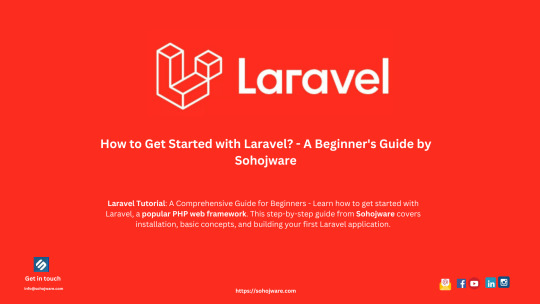
How To Get Started With Laravel? — A Beginner’s Guide By Sohojware
Laravel, a free, open-source PHP web framework, has become popular worldwide for web developers. Laravel streamlines development by providing a robust foundation for building modern web applications. This comprehensive guide from Sohojware, a leading US-based software development company, will equip you with the essential knowledge to embark on your Laravel development journey.
Why Choose Laravel?
There are many reasons why Laravel stands out in the world of web frameworks. Here are a few key benefits:
Elegant MVC Architecture: Laravel enforces the Model-View-Controller (MVC) design pattern, promoting clean code separation and maintainability. This structure makes your code easier to understand, test, and scale as your application grows.
Object-Oriented Approach: Built on top of PHP’s object-oriented capabilities, Laravel fosters code reusability and promotes a well-organized development workflow.
Built-in Features: Laravel comes packed with a plethora of pre-built functionalities, including authentication, authorization, routing, caching, database management, and more. This saves you time and effort by eliminating the need to develop these features from scratch.
Artisan CLI Tool: Laravel’s powerful command-line interface (CLI) tool, Artisan, simplifies common development tasks like generating models, migrations, controllers, and other boilerplate code. This speeds up development significantly.
Active Community and Ecosystem: Laravel boasts a large and active community of developers who contribute to its continuous improvement. This ensures access to extensive documentation, tutorials, and readily available packages for various functionalities.
Getting Started with Laravel
Now that you’re convinced about the advantages of Laravel, let’s delve into the steps to get you started:
1. Prerequisites:
Before diving into Laravel development, ensure you have the following tools installed on your system:
PHP (version 7.4 or later): Download and install the latest version of PHP from the official website (https://www.php.net/downloads/).
Composer: Composer is a dependency manager for PHP. Follow the installation instructions on the Composer website (https://getcomposer.org/).
2. Install Laravel:
There are two primary methods for installing Laravel:
Method 1: Using Composer:
Open your terminal and navigate to your desired project directory. Then, run the following command:
Bash

Replace “your-project-name” with your preferred application name. This command will create a new Laravel project directory with all its dependencies installed.
Method 2: Using Laravel Installer:
If you don’t have Composer installed, you can download the Laravel installer from the official website ([invalid URL removed]). Once downloaded, execute the following command in your terminal:
Bash

3. Set Up Database:
Laravel utilizes a database to store application data. You can choose from various database management systems like MySQL, PostgreSQL, or SQLite. Configure your database credentials in the .env file located at the root of your project directory.
4. Start the Development Server:
Laravel provides a built-in development server to run your application locally. Navigate to your project directory in the terminal and execute the following command to start the server:
Bash
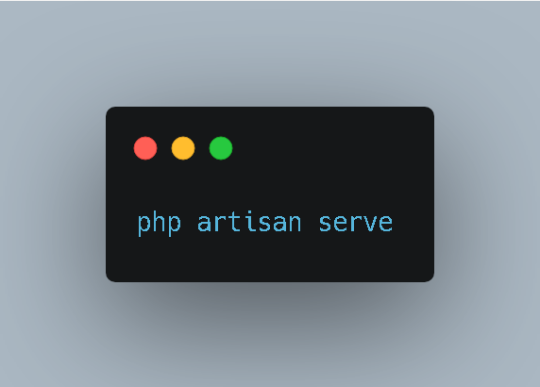
This will typically launch your application at http://localhost:8000 in your web browser.
5. Explore the Project Structure:
Laravel adheres to a well-defined directory structure, making locating and managing different application components easy. Take some time to familiarize yourself with the key directories like app, config, public, resources, and routes, each serving specific functionalities.
Building Your First Laravel Application
Now that you have a basic Laravel setup, let’s create a simple application to demonstrate its functionalities. We’ll build a basic blog system where users can view a list of posts.
1. Create a Model:
A model represents the data structure of your application. To create a model for posts, run the following Artisan command in your terminal:
Bash
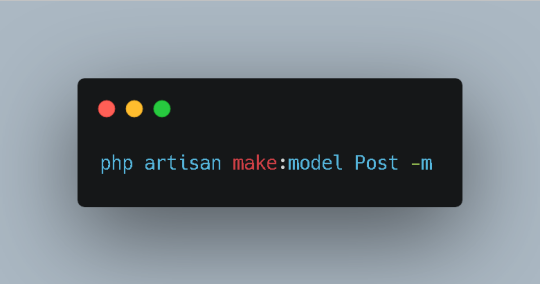
This command generates a Post.php file within the app directory. Modify this file to define the attributes associated with a post, such as title, content, and author.
2. Create a Migration:
A migration is a version control system for your database. It allows you to define changes to your database schema and easily roll them back if necessary. To create a migration for the Post model, run the following Artisan command:
Bash
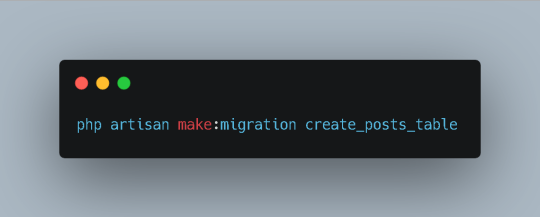
This will generate a new migration file within the database/migrations directory. Open the file and add the necessary columns to the up method. For example:
PhP
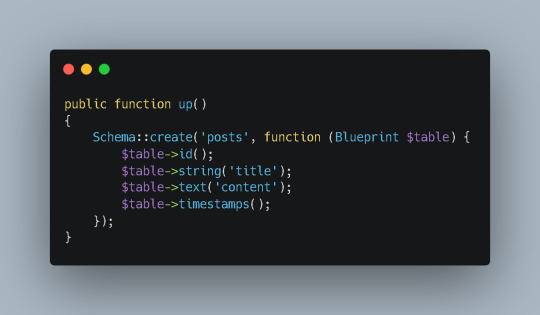
3. Run the Migration:
To apply the changes defined in the migration to your database, run the following command:
Bash
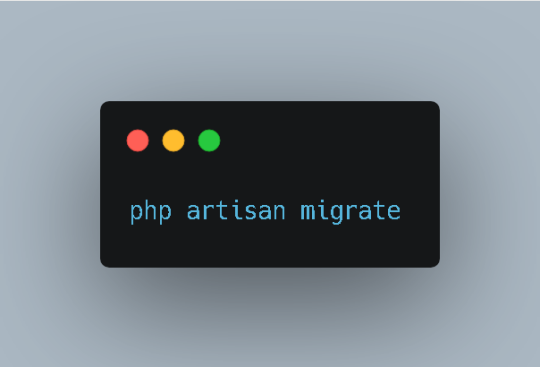
This will create the posts table in your database.
4. Create a Controller:
A controller handles user requests and interacts with your models. To create a controller for managing posts, run the following Artisan command:
Bash

This will generate a PostController.php file within the app/Http/Controllers directory. Inside the controller, define methods to handle different actions, such as displaying a list of posts, creating a new post, and editing or deleting existing posts.
5. Define Routes:
Routes map URLs to specific controller actions. To define routes for your blog application, open the routes/web.php file and add the following code:
Php

This route will map the root URL (http://localhost:8000) to the index method of the PostController class.
6. Create a View:
Views are responsible for rendering HTML content. To create a view for displaying the list of posts, run the following Artisan command:
Bash
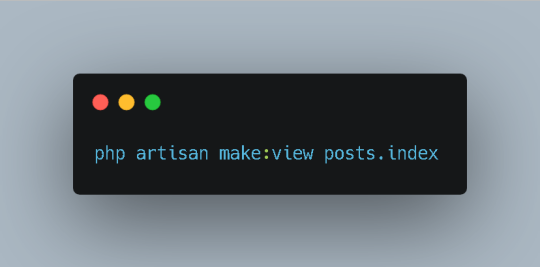
This will generate a posts/index.blade.php file within the resources/views directory. Inside the view, write the HTML code to display the list of posts.
7. Complete the Controller:
In the index method of the PostController, retrieve the list of posts from the database using the Post model and pass it to the view:
PhP

8. Test Your Application:
Access http://localhost:8000 in your web browser to see the list of posts displayed on the page.
Conclusion
This guide has provided you with a solid foundation for getting started with Laravel. By following these steps and exploring the framework’s rich features, you can efficiently build robust and scalable web applications. Remember, practice is key to mastering Laravel. Start experimenting with different features and building your own projects to enhance your skills.
FAQs
What is the difference between Laravel and CodeIgniter?
Laravel and CodeIgniter are both popular PHP frameworks, but they have distinct approaches and features. Laravel emphasizes convention over configuration and provides a more expressive syntax, while CodeIgniter offers a more lightweight and flexible structure. The choice between the two often depends on project requirements and developer preferences.
Can I use Laravel for large-scale applications?
Absolutely! Laravel is designed to handle complex and high-traffic applications. Its robust architecture, scalability features, and active community support make it a suitable choice for enterprise-level projects.
How does Laravel compare to other popular frameworks like Symfony and Yii?
Laravel, Symfony, and Yii are all powerful PHP frameworks with their own strengths and weaknesses. Laravel is known for its ease of use and expressive syntax, Symfony offers a more modular and customizable approach, and Yii emphasizes performance and efficiency. The best framework for your project depends on your specific needs and preferences.
Does Sohojware offer Laravel development services?
Yes, Sohojware provides professional Laravel development services. Our team of experienced developers can help you build custom Laravel applications tailored to your business requirements.
How can I learn Laravel more effectively?
The best way to learn Laravel is through hands-on practice and experimentation. Start by following tutorials and building small projects. As you gain confidence, gradually tackle more complex applications. Additionally, consider joining online communities and forums where you can connect with other Laravel developers and seek help when needed.
1 note
·
View note
Text
Top Reasons Why Laravel is the Best Choice for Your SaaS Business in 2024

Laravel, a well-known PHP framework, has emerged as a top choice for developing strong and scalable SaaS (Software as a Service) applications. Its vast features and capabilities make it suitable for creating complex web-based applications that fit the needs of today's organizations. Here are the main reasons why you should choose Laravel for SaaS business development in 2024:
1. Robust Framework: Laravel is known for its robustness and stability. It provides a solid foundation for building complex web applications, including SaaS platforms. The framework offers built-in features such as authentication, routing, sessions, and caching, which are essential for developing secure and efficient applications.
2. Elegant Syntax: Laravel's syntax is clean, elegant, and expressive, making it a joy to work with. The ability of developers to generate legible and maintainable code is essential for collaborative SaaS projects whose needs change over time.
3. Rapid Development: Laravel significantly speeds up the development process with its powerful toolkit and modular architecture.With pre-built components like Blade templating engine, Eloquent ORM, and Artisan CLI, developers can concentrate on business logic instead of tedious activities.
4. Security Features: Security is paramount for SaaS applications handling sensitive user data. Laravel offers built-in security features such as hashed password storage, protection against SQL injection, and cross-site request forgery (CSRF) protection. Additionally, Laravel follows best practices for web application security.
5. Community Support: Laravel has a large and active community of developers who contribute to its growth and offer support through forums, tutorials, and open-source packages. This community-driven ecosystem ensures that Laravel remains up-to-date with the latest trends and security patches.
6. RESTful APIs: Laravel makes it easy to build RESTful APIs with its built-in support for API development. This is crucial for SaaS applications that need to integrate with other services or provide a robust API for third-party developers.
7. Code Reusability: Laravel promotes code reusability and maintainability through its modular structure and support for components such as packages and libraries. This allows developers to reuse existing code across different parts of the application, saving time and effort.
8. Community Packages: Laravel's ecosystem has been enhanced with an array of community-contributed packages that enhance its capability. These solutions include everything from authentication and authorization to payment gateways and connectivity with popular services.
Why Choose XcelTec for Laravel Development Services?
XcelTec offers top Laravel development services in the USA, backed by an experienced team of Laravel developers specialized in building websites and web-based applications. As a Laravel development service provider, XcelTec has a proven track record of delivering high-quality Laravel solutions tailored to meet the unique needs of SaaS businesses.
If you're looking to develop a SaaS application in 2024, Laravel is undoubtedly the best choice. Its robust framework, elegant syntax, rapid development capabilities, security features, and strong community support make it the ideal platform for building scalable and secure SaaS applications. Partner with XcelTec to leverage the power of Laravel and propel your SaaS business forward.
#Laravel Web Development#laravel website development services#Laravel#Laravel Development company#laravel development company usa#laravel development company#laravel development
0 notes
Text

A Step-by-Step Guide for App Development
Introduction: Selecting the right framework for your app development project is crucial for its success. With a myriad of options available, it can be overwhelming to determine which framework best suits your needs. This step-by-step guide will help you navigate the process and find the perfect fit for your app development endeavor.
Step 1: Define Your Project Requirements Begin by clearly defining the requirements of your app project. Consider factors such as the desired functionality, target platforms (web, mobile, desktop), scalability needs, performance requirements, and any specific technology stack preferences. This initial step will provide a clear roadmap for selecting a framework that aligns with your project goals.
Step 2: Research Available Frameworks Once you've outlined your project requirements, research available frameworks that meet your criteria. Explore popular options such as React.js, Angular, Vue.js, Flutter, Django, Laravel, and others. Consider factors such as programming language compatibility, community support, scalability features, performance optimizations, and security capabilities.
Step 3: Assess Community Support and Resources Evaluate the community support and resources available for each framework. Look for active forums, documentation, tutorials, and online communities where developers share insights, troubleshoot issues, and offer support. A vibrant community can be invaluable for learning, troubleshooting, and staying updated on best practices within the framework ecosystem.
Step 4: Evaluate Development Speed and Productivity Consider the development speed and productivity features offered by each framework. Look for tools and features that streamline the development process, such as code generation, scaffolding, built-in libraries, and reusable components. Faster development cycles can help accelerate time-to-market and reduce development costs.
Step 5: Consider Flexibility and Customization Options Assess the level of flexibility and customization options provided by each framework. Determine whether the framework allows you to tailor the app to your specific requirements and preferences. Consider factors such as extensibility, modularity, and the ability to integrate with third-party libraries and services.
Step 6: Prioritize Security and Maintenance Prioritize frameworks that prioritize security and offer robust maintenance and support. Look for frameworks with built-in security features and regular updates to address vulnerabilities and compatibility issues. Ensure that the framework is actively maintained and supported by a dedicated development team.
Step 7: Prototype and Experiment Prototype and experiment with the frameworks that best align with your project requirements. Build small-scale prototypes or proof-of-concept projects to gain hands-on experience with each framework's features, capabilities, and development workflow. This practical experimentation will help you make informed decisions based on real-world experience.
Step 8: Seek Feedback and Consult Experts Seek feedback from peers, colleagues, and industry experts who have experience with the frameworks you're considering. Leverage online communities, forums, and developer networks to gather insights, ask questions, and solicit recommendations. Consulting with experts can provide valuable perspectives and help validate your framework choices.
Step 9: Make an Informed Decision After thorough research, experimentation, and feedback gathering, make an informed decision on the framework that best fits your app development needs. Consider all factors, including project requirements, community support, development speed, flexibility, security, and maintenance considerations. Choose the framework that offers the best balance of features and capabilities for your specific project goals.
Conclusion: Selecting the right framework is a critical step in the app development process. By following this step-by-step guide, you can navigate the framework landscape with confidence, find the perfect fit for your project, and set the foundation for app development success.
For inquiries, drop us an email at [email protected] or give us a call at +91 9711141179. Connect with us on social media: https://linktr.ee/coderower
#app development#applications#app developers#android app development#mobile app development#web app development#app developing company
0 notes
Text
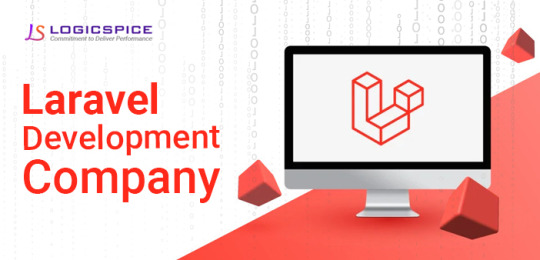
Unleashing the Power of Laravel: A Comprehensive Guide for Web Development Companies
In the ever-evolving landscape of web development, Laravel has emerged as a game-changing PHP framework, empowering developers and companies alike to create robust, scalable, and feature-rich web applications with unparalleled efficiency. This comprehensive guide delves into the key aspects of Laravel that make it a standout choice for web development companies seeking to streamline their processes and deliver exceptional results.
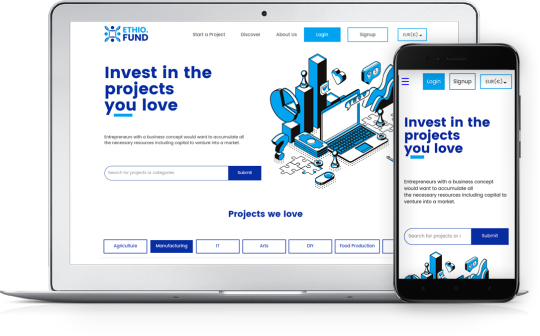
1. The Elegance of Laravel's Syntax: Laravel's syntax is renowned for its elegance and expressiveness, setting it apart from traditional PHP programming. With its clean and readable code structure, developers can write maintainable and collaborative codebases, reducing the time and effort required for onboarding new team members or revisiting legacy code.
2. Eloquent ORM: Simplifying Database Interactions: Laravel's Eloquent ORM (Object-Relational Mapping) is a powerful tool that simplifies database interactions, allowing developers to work with complex data structures effortlessly. With its advanced features like relationships, mutators, and accessors, Eloquent streamlines database operations, saving precious development time and resources.
3. Robust Security: A Top Priority: Web application security is a critical concern for any development company, and Laravel excels in this area. Its built-in features for handling user authentication, password resets, and role-based access control ensure that applications are secure from the ground up. Additionally, Laravel's robust security features can be easily customized and extended to meet specific project requirements, providing peace of mind for both developers and clients.
4. Intuitive Routing and URL Structure: Laravel's intuitive routing system allows developers to define clean and user-friendly URLs for their applications. From handling CRUD operations with resource routing to creating custom routes and middleware, Laravel's routing capabilities are both powerful and flexible, enabling Laravel web development services companies to deliver seamless user experiences.
5. Ecosystem of Packages and Tools: One of Laravel's greatest strengths lies in its vast ecosystem of packages and tools contributed by its vibrant community. Whether a project requires social media integration, subscription billing, or advanced features like real-time notifications, Laravel's package ecosystem offers a wealth of solutions, accelerating development timelines and reducing the need for reinventing the wheel.
6. Emphasis on Testing and Quality Assurance: Laravel's strong emphasis on testing is a game-changer for web development companies seeking to deliver high-quality, reliable applications. With built-in support for unit testing, feature testing, and browser testing with Laravel Dusk, developers can write robust and maintainable code with confidence, ensuring a seamless user experience and facilitating future upgrades and refactoring.
7. Vibrant and Supportive Community: Laravel's community is one of its greatest assets, providing a vast network of developers, extensive documentation, tutorials, and forums. This supportive ecosystem ensures that web development companies have access to valuable resources and best practices, enabling them to tackle any challenge and stay at the forefront of web development innovation.
8. Scalability and Performance: As web applications grow in complexity and user base, scalability and performance become critical considerations. Laravel's architecture and features, such as caching, queuing, and load balancing, empower web development companies to build applications that can handle high traffic and scale seamlessly, ensuring a smooth user experience even under heavy loads.
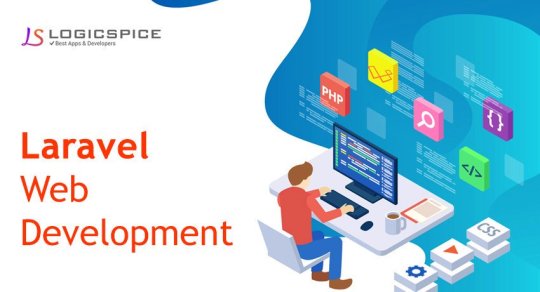
By leveraging the power of Laravel, laravel development companies can streamline their processes, enhance collaboration, ensure robust security, deliver exceptional user experiences, and stay ahead of the curve in the ever-changing web development landscape. With its elegant syntax, powerful ORM, robust security features, intuitive routing, extensive package ecosystem, emphasis on testing, vibrant community, and scalability, Laravel is the ultimate framework for companies seeking to unlock their full potential in web development. If you're seeking a reliable and skilled partner to bring your Laravel-powered web applications to life, look no further than LogicSpice. As a leading Laravel development company, they have a proven track record of delivering exceptional results, leveraging the full potential of this powerful framework to craft scalable, secure, and high-performing solutions tailored to your business needs.
#laravel web development company#laravel development company#laravel development services#laravel app development company#laravel app development services#laravel agency#laravel company
0 notes